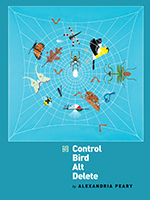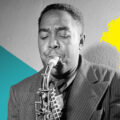Reboot: Landscape: New England

Control Bird Alt Delete
Alexandria Peary
$19.00, Softcover
2014, Iowa University Press
Alexandria Peary’s Control Bird Alt Delete is her third book of poetry and winner of the 2013 Iowa Poetry Prize. It is a collection that plays with the idea of place, and begins with a landscape both recognizable and strange. “Fridge,” the opening piece, draws on well-trod images of rural New England, such as the “gathering of birches” described at the start of the poem—a bucolic cliché used notably by Robert Frost and those who have followed him. But much of the rest of the imagery of the poem is unsettling and full of long-forgotten, recently-discovered relics: dairy cow bones, a filled-in cellar hole. It is a “dreaming place,” where memory and imagination operate as immediately as the senses do.
Peary evokes a half-folksy rural atmosphere, though, to demonstrate that certain modes of life can no longer exist, that they perhaps never did. In “Deconstructing New England”, she addresses the effects of deforestation, quoting from geologist Robert M. Thorson’s Stone by Stone: “By the middle of the nineteenth century, when de / forestation reached its peak, more than half / of New England’s native forests … as much as 80 percent in the heavily settled parts of southern New England—had been cut down.” Peary’s speaker once again considers a place where she used to live, looking at the “no-longer houses” and conceding that she never knew her neighbors well. The ruined landscape and lack of significant connection between people go hand in hand.
Despite her philosophical deconstruction of the landscape and its inhabitants, the writing exhibits a tender interest in the artifacts described. The birches of “Fridge” gather as if for a ritual imagined by the speaker, and from the center of the trees “a 1950s jay-blue fridge” rises, “shaking its ratty cord”. Both “jay-blue” and “cord” deserve close attention, for the words play cognitive tricks—ones repeated throughout the book. First, Peary accomplishes a sleight-of-hand with the reversal in “jay-blue.” Primed by the title Control Bird Alt Delete and the woodsy setting, a reader anticipates the bird; but this is no clichéd sylvan landscape. In its place lies an industrial dump: “the rubble / of the Necco candy factory,” abandoned band-name mattresses, old dishwashers, and an antique discarded refrigerator.
The titular fridge is animate and full of agency, “shaking its ratty cord.” The “jay” primes a reader for birdsong and, by some extension, for “chords” rather than “cords.” The mixed associations of chord/cord—and the play with sound, spelling, and cognitive association—return midway through the book in “The Ceiling,” when Peary writes of a hanging “chord.” The sound is later made solid, in “The Neighbors,” where “a chord from Beethoven is suspended in the sky.”
The music in the work is made visual—Beethoven’s music is seen, as is the homonym—and this interest in painterly vision is clear throughout the collection. Birdsong is squeezed out of tubes, like paint, or revealed in needlepoint. Peary writes in her notes that the bird poems are based on illustrations by Charley Harper, a modernist artist known for his stylized, colorful, and exuberant depictions of plants and animals. One poem of the collection contains “the fuzzy pastels of bird song” and later “Bird Pattern,” which features the bold prime colors the artist favors, has “Charley Harper wrestling / with Audubon,” the monolithic nineteenth-century ornithologist, painter, and author of Birds of America.
But Harper and Audubon are not the only painters to have attracted Peary’s attention. She also alludes to the German-Swiss painter Paul Klee in “Klee Carpets.” Like Harper’s work, Klee’s art is flat, boldly colored, and stylized. As an artist closely associated with music and poetry—the poet Rainier Maria Rilke compared his work to musical transcriptions—Klee is a fitting choice for poems in which the senses are riotously mixed. The influence of both Klee and Harper is visible throughout, but “Bird Pattern” in particular has some exquisitely condensed riffs, including “the grey, striped sound of the highway. That red zigzag, that sunflower seed, that yellow authority.”
Color and shape are prominent component throughout Peary’s work. She writes about “bird patterns” (an allusion to Harper’s dense depictions of flora and fauna) as well as mazes, schematics, and designs. Of course, the letters, words, and symbols on the page also generate visual patterns. Peary is keenly interested in the effect of typography and punctuation. In “Lilacs as Chart” and “Lilacs” she considers the letter “e”—a sound or a musical note, but also a typographic letter which can be “electronic and / embroidered.” Here the writer reaches both forward and backward, alluding to the easy “e” typed on a word processor and the carefully hand-crafted “e” in a piece of needlepoint.
New images arise from punctuation marks and typography, too, as the speaker makes “the e’s perform / like emoticons of grumpy old men”—one of many nods to the digital age; elsewhere, Peary imagines a hallway made of dashes and hyphens. In “Song-Maze” she sees “superscript / to a forest of vowels” and in “Surveillance Meteor” the writer has her reader visualize the monumental capitalization of “the PVBLIC LIBRARY.” Here it is important that the words be read on the page, rather than heard: the sound in both cases is the same, but “the PVBLIC LIBRARY” evokes a self-conscious grandeur that the public library does not. Peary describes an “A-frame house in Seraph font” where the misspelling of seraph (an angel) for serif (a typographical embellishment) is glaring, like the misuses of chord/cord. In both cases, one must read carefully what is on the page, not just hear it, to catch the meaningful homophone. The work abounds with these cognitive associations, slips, and linguistic games. Words draw attention to the play of their visual shapes, the sounds they give rise to, and the meanings they may or may not have.
The clash of sound, image, and word is pleasing, but also disorienting. What does it mean, for instance, when Peary writes about “a yellow authority”? Or when she describes a “white idea in a dream” and a “jungle of green asterisks”? Abstractions like these are colored only in and by the imagination. In this sense, the writer does what the painter cannot do. Peary seems fully aware of the challenges she presents, and deliberately draws attention to them. To what end, though?
The reader may frantically try to make sense of Peary’s improbable formulations—we try to find patterns in the chaos because “the mind likes categories” (“Flora to Fauna”). Written language, after all, is a means of organizing the chaos of thought. But synesthetic, plural, interstitial art is difficult (if not uncommon). Peary embraces the uncertain and the impossible, just as she acknowledges human beings’ pattern-finding nature. But when the pattern is upset or upended—when we get a jay-blue fridge rather than a blue jay in the woods—perhaps that is where poetry happens. We may not see an idyllic sylvan landscape in “Fridge” or in “Deconstructing new England,” but we are given a world of new possibilities—a landscape “where a cellar hole could be / a hyperlink.” The possibilities are unsettling and strange, but they are also fun, and the speaker in “Fridge” urges us to “go play.”
About Nora Delaney
Nora Delaney is a poet, translator, and critic. She received her PhD from the Editorial Institute of Boston University. Her writing can be found in Literary Imagination, Two Lines Online, Absinthe: New European Writing, Subtropics, Pusteblume, Little Star, Fulcrum, The Arts Fuse, and elsewhere.





